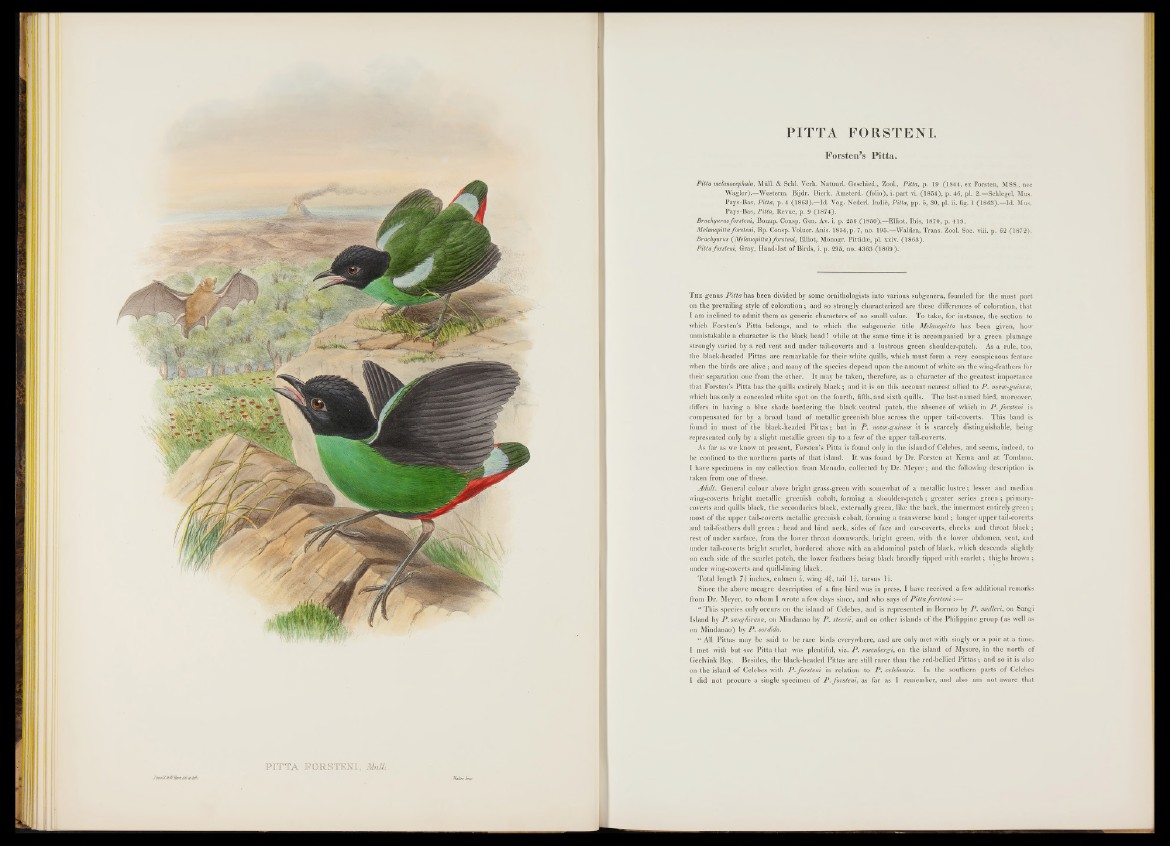
PITTA FORSTEN!.
F o rs te rs Pitta.
Pitta melanocephala, MUll. & Schl. Verh. Natuurl. Geschied., Zool., Pitta, p. 19 (1844, ex Forsten, MSS., nec
Wagler).—Westerm. Bijdr. Dierk. Amsterd. (folio), i. p art vi. (1854), p. 46, pi. 2.—Schlegel, Mus.
Pays-Bas, Pitta, p. 4 (1863).—Id. Vog. Nederl. Indie, Pitta, pp. 5, 30, pi. ii. fig. 1 (1863).—Id. Mus.
Pays-Bas, Pitta, Revue, p. 9 (1874).
Brachjurusforsteni, Bonap. Consp. Gen. Av. i. p. 256 (1850).—Elliot, Ibis, 1870, p. 419.
Melanopitta forsteni, Bp. Consp. Yolucr. Anis. 1854, p. 7, no. 195.—Walden, Trans. Zool. Soc. viii. p. 62 (1872).
Brachyurus (Melanopitta) forsteni, Elliot, Monogr. Pittidse, pi. xxiv. (1863).
Pitta forsteni, Gray, Hand-list of Birds, i. p. 295, no. 4363 (1869).
T he genus Pitta h a s been divided by some ornithologists into various subgenera, founded for the most part
on the prevailing style o f coloration ; and so strongly characterized are these differences of coloration, that
I am inclined to admit them as generic characters o f no small value. To take, for instance, the section to
which Forsten’s Pitta belongs, and to which the subgeneric title Melanopitta has been given, how
unmistakable a character is the black h e a d ! while at the same time it is accompanied by a green plumage
strongly varied by a red vent and under tail-coverts and a lustrous green shoulder-patch. As a rule, too,
the black-headed Pittas are remarkable for their white quills, which must form a very conspicuous feature
when the birds are alive; and many o f the species depend upon the amount o f white on the wiug-feathers for
their separation one from the other. I t may be taken, therefore, as a character of the greatest importance
th at Forsten’s Pitta has the quills entirely b lack ; and it is on this account nearest allied to P. novce-guinece,
which has only a concealed white spot on the fourth, fifth, and sixth quills. The last-named bird, moreover,
differs in having a blue shade bordering the black ventral patch, the absence o f which in P. forsteni is
compensated for by a broad band o f metallic greenish blue across the upper tail-coverts. This band is
found in most of the black-headed P itta s ; but in P. nooce-guinece it is scarcely distinguishable, being
represented only by a slight metallic green tip to a few o f the upper tail-coverts.
As far as we know at present, Forsten’s P itta is found only in the island o f Celebes, and seems, indeed, to
be confined to the northern parts of th at island. I t was found by Dr. Forsten a t Kema and at Tondano.
I have specimens in my collection from Menado, collected by Dr. Meyer; and the following description is
taken from one o f these.
Adult. General colour above bright grass-green with somewhat of a metallic lu s tr e ; lesser and median
wing-coverts bright metallic greenish cobalt, forming a shoulder-patch; greater series green ; primary-
coverts and quills black, the secondaries black, externally green, like the back, the innermost entirely green ;
most o f the upper tail-coverts metallic greenish cobalt, forming a transverse band ; longer upper tail-coverts
and tail-feathers dull greeu ; head and hind neck, sides o f face and ear-coverts, cheeks and throat black ;
rest o f under surface, from the lower throat downwards, bright green, with the lower abdomen, vent, and
under tail-coverts bright scarlet, bordered above with an abdominal patch o f black, which descends slightly
on each side of the scarlet patch, the lower feathers being black broadly tipped with sc a rle t; thighs brown ;
under wing-coverts and quill-lining black.
Total length 7 \ inches, culmen $, wing 41, tail 1$, tarsus H.
Since the ahove meagre description o f a fine bird was in press, I have received a few additional remarks
from Dr. Meyer, to whom I wrote a few days since, and who says o f Pitta forsteni:—
“ T his species only occurs on the island o f Celebes, and is represented in Borneo by P. mulleri, on Sangi
Island by P. sanghirana, on Mindanao by P. steerii, and on other islands of the Philippine group (as well as
on Mindanao) by P. sordida.
“ All Pittas may be said to be rare birds everywhere, and are only met with singly or a pair a t a time.
I met with but one Pitta th at was plentiful, viz. P. rosenbergi, on the island of Mysore, in the north of
Geelvink Bay. Besides, the black-headed Pittas are still rare r than the red-bellied P itta s ; and so it is also
on the island o f Celebes with P . forsteni in relation to P . celebensis. In the southern parts o f Celebes
1 did not procure a single specimen o f P. forsteni, as far as 1 remember, and also am not aware that